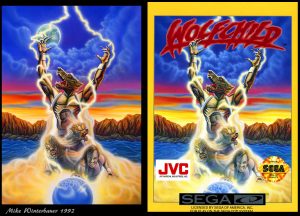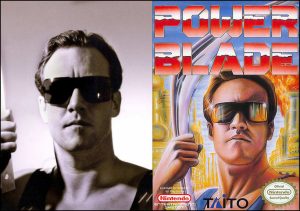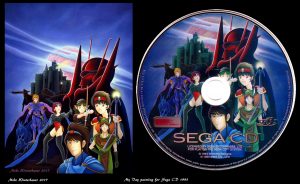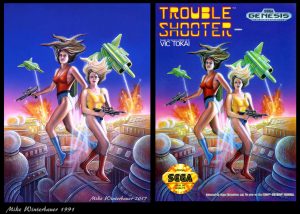 Video game covers used to be something gamers looked forward to. Some of the most famous games of the ‘8- and 16-bit eras are instantly remembered because of their cover art, and many people were often dismayed when the original Japanese art was swapped out for that of a western artist. Sometimes it was for the better, sometimes for the worse, but there was always discussion to be had about video game cover art (Master System games, anyone?)
Video game covers used to be something gamers looked forward to. Some of the most famous games of the ‘8- and 16-bit eras are instantly remembered because of their cover art, and many people were often dismayed when the original Japanese art was swapped out for that of a western artist. Sometimes it was for the better, sometimes for the worse, but there was always discussion to be had about video game cover art (Master System games, anyone?)
Deeply involved in that topic is Mike Winterbauer, an award-winning artist who created some of the iconic PC and console game art of the ’80s and ’90s, including Might & Magic (PC), Powerblade (NES), Vay (Sega CD), and Trouble Shooter (Genesis). Winterbauer’s work has also graced the covers and pages of video game magazines, such as Swim and Kids & Computers, as well as multiple movie covers.
We recently chatted with Mr. Winterbauer about his work and the covers he did for some classic Sega games.
Sega-16: How did you start making art for video games?
Mike Winterbauer: That is an interesting question because the earliest game painting I did was done in 1985 but published in 1990. My DoubleStrike NES cover was actually a painting I did for my Advanced Rendering Class at Art Center in 1985. The painting was originally done as a self-promotional piece intended to sell sunglasses. In 1988, I used the painting in an American Showcase ad. In 1989 American Video Entertainment saw the ad and asked if I could put a fighter jet in the sunglasses. I promptly added the two fighter jets and sunset reflection to the sunglasses and sold the painting, to my delight. American Video Entertainment used my revised painting for the cover of their new game called DoubleStrike. This was one of several Art Center paintings I did that were published commercially.
The first actual commissioned game cover I did was in 1989 for a World War I simulation game that was for the PC called War Eagles. This was my first experience doing a cover for a computer game, and I was very excited and fortunate to get the job. I got the job from either a referral or me contacting them and showing work. I remember thinking that there must be many other opportunities for computer game cover work. I immediately started creating lists of all the computer game companies and finding out who the art directors were so that I could contact them and show my work.
I was living in Pasadena in the ’80s & ’90s and discovered there were many computer game companies in the surrounding areas. I would make hundreds of calls weekly setting up appointments to personally show my artwork. I found I had a much greater chance of getting the job when I presented my portfolio in person. I used to line up three to four portfolio showings in a day all over Los Angeles.
My little red Mazda GLC hatchback and I became very familiar with the roads of Los Angeles. Through it all, I realized the only person who is going to make your dreams come true is yourself. I am a highly motivated individual, and the experience also taught me if you want to be an artist, you better have thick skin and believe in yourself.
 Sega-16: Are you a video gamer yourself?
Sega-16: Are you a video gamer yourself?
Mike Winterbauer: I am not a hardcore gamer; I am an artist who enjoys games for the ideas, imagination, technology, and the worlds they create. I love games and the stories they tell. Games lend themselves brilliantly to the illustration world. I have been able to paint heroes, villains, castles, creatures, faraway lands, space ships, and many other spectacular things because of computer games.
I have not played all the games I created covers for, but I played parts of them when available to understand and get the feel of the game. Sometimes, I was given screenshots and a summary of what the game was about and asked to come up with a concept for the box. This was before full-blown computer-generated graphics, and the games had a bitmap feel, and great gameplay was crucial to the success of the game. The box cover reflected the imaginative experience of playing the game.
It was a great time for artists to create fantastic artworks to sell computer games. The art was created to reflect the feeling and imaginative world the gamer would encounter playing the game. This is a much different approach to game boxes of today. Today, game boxes have a slick, computer-generated feel from rendered models or retouched screens from the actual game. Traditional illustration box art has become a lost art because of the rise of technology.
This time period of 1980-95 is unique in the history of art and pop culture. There was an avalanche of fantastic creativity in painting and print before the birth of the digital world and desktop publishing. 1995 marked the decline of traditional illustration and print collateral, swept aside for the easier and cheaper digital and online resources becoming readily available. It was a truly sad turning point for traditional artists who were passionate about their art and wanted it to be seen by the public.
Sega-16: You often had little to go on about a game before creating its cover, correct? What did you draw on for inspiration?
Mike Winterbauer: Almost always I was given minimal information about the game I was supposed to do cover art for. One of the exceptions is the Might & Magic covers and the maps I did art work for, I was well-informed about the game and characters. Typically, I was handed screen shots and a synopsis of what the game was about. The games had a low-res quality about them, so the storyline and gameplay were integral to the success of the game. This enabled me to be very creative in coming up with a cool idea for the box cover.
This was a great time to be a cover artist, as I was given significant freedom to create a super cool box cover. I was asked to come up with an idea that would portray the game but also make a fantastic box cover. The coming up with the concept for the cover illustration was the first and very important task of creating classic cover art. The box covers had to have a “wow” factor that would separate them from the many other boxes on the shelves and stand out in the magazines. There was no digital media or Internet to advertise in. Advertising was done in print, and mostly box art and magazines were the point of contact with the consumer.
I designed covers that hopefully made people want to imagine and play the game. This was a very fun and creative approach. I studied lots of other art to understand and inspire me to create Classic Game Covers. I wanted to know what had been done and what had worked well so I could create something unique and powerful.
I admire many artists and games, too many to list here. I enjoy looking at many artists work, and I have very eclectic tastes. Some of my favorite artists are Frank Frazetta, Sid Mead, JC Leyendecker, Roy Krenkel, Maxfield Parrish, Norman Rockwell, Dean Cornwell, Alphonse Mucha, John Singer Sargent, Gustav Klimt, Claude Monet, William-Adolphe Bouguereau, Auguste Rodin and Toulouse-Lautrec.
As far as game covers I admire, there are many awesome covers I like over the years. I am partial to the cover of Myst. The game was unique and beautiful and set the stage for future games. I think the graphics in Myst are very beautiful and the cover has a unique, mysterious, and ethereal quality that makes you want to see more of the game.
Sega-16: How long did it typically take to do a painting for one of the game covers?
Mike Winterbauer: The amount of time and energy that went into these paintings is a true labor of love. These are my children. I literally lived and breathed them to life.
Most people don’t understand what it takes to create one of these illustrations. Everything on the board has been designed and drawn to work in the space on the board. The drawing alone could take a week to do. Then, you have to figure out the color with color comps. I used prisma color pencils on photocopies of my original drawing. It was a great way to work up different color schemes for clients. Then came the painting process, which could easily be 60-plus hours on most of the covers. This is not like being a doctor or a lawyer. You work many hours for just one commission, and getting the client to pay could even be more difficult than completing the painting.
The Might & Magic paintings I had a lot of time to paint. I worked on each of the pieces for well over a month, as there was plenty of time to paint each of them. They were all large paintings, being 30 by 40 inches on board, and I wanted each of them to be the very best I could make them. I hoped that the paintings would one day become valuable, and that is why I painted them larger, as larger collectible paintings can be highly sought after.
Sega-16: Most of your game covers were for computer titles, particularly the Might & Magic series. Was creating covers for console games a different process, or did companies more or less approach them the same way, regardless of platform?
Mike Winterbauer: The platform did not matter when companies asked me to do a cover for a game. The process was exactly the same. The only difference was the final printed size of the illustration. I needed to know what proportion to paint the illustration so it would fit correctly on the box.
Looking back on some of the projects, I remember getting the commission to paint the cover of Ninja Taro for the Game Boy. The console was so new, I said to them “what is a Game Boy?” This is a unique and funny statement which reflects “being in the right place at the right time or being smart enough to be in the right place at the right time.”
I realized I was at the door of a golden opportunity to get my work seen for future generations. These new computer games were becoming the hottest new entertainment in the world, and they needed cover art. I was at the beginning of something great and quickly learned all I could about who and where these new cool games were being made.
Sega-16: You frequently used yourself as a model for some of your paintings, including the cover to the 1990 NES classic Powerblade. When did you decide to just “do it yourself” for your covers?
 Mike Winterbauer: I always took my own photos to work from whenever I possibly could. The reason being that your work will always be original and created entirely by you. The other reason being that it is much more affordable to use myself and friends for models than paying models. I was on a budget and wanted to make sure I kept my costs down on the projects. I believed I could model the character very well, as I knew exactly the attitude and pose I wanted to paint. Also, it was just a ton of fun to act out these different characters with my friends and take pictures to work from.
Mike Winterbauer: I always took my own photos to work from whenever I possibly could. The reason being that your work will always be original and created entirely by you. The other reason being that it is much more affordable to use myself and friends for models than paying models. I was on a budget and wanted to make sure I kept my costs down on the projects. I believed I could model the character very well, as I knew exactly the attitude and pose I wanted to paint. Also, it was just a ton of fun to act out these different characters with my friends and take pictures to work from.
PowerBlade was a wonderful project and I felt very lucky to have been able to get the job. I remember being told the game had a Terminator, feel to it and I was asked if I could do a cover that had a similar attitude. I was very excited to work on the project, being a huge fan of the film. I realized I would need original reference to paint from and started figuring out the best approach. So, I set up a photoshoot that had a Terminator feel to it, which is really all about attitude.
The fluorescent lights in my studio provided an ominous and stark feeling when the model was under them. Dramatic lighting on the model is absolutely critical to getting an awesome photo to work from. I started by photographing two of my friends posing with a metal T-square. The photos were good but not great, they lacked the attitude that was needed to make the cover awesome. So, I asked them to let me try the pose and take a picture of me holding the T-square. The photo turned out very well, so I decided to use it to paint from. The cover of PowerBlade is a self-portrait of myself, and I smile every time I see the cover. It’s not every day you get your portrait on the cover a classic game box.
When the cover was published, I received a letter from copyright lawyers asking what reference I used to paint from. I sent them the picture of myself holding a T-Square, and that was the end of it. The funny thing is, I actually appear on a lot of my cover art, and it became a running joke with my friends and family. I am also the character in the WolfChild painting who has his hand above the magic orb on the right side.
Sega-16: Your cover for Trouble Shooter is an interesting one! How did it come about?
Mike Winterbauer: The cover for Trouble Shooter is really fun and colorful. It was intended to have an unusual, fun look that would encourage consumers to take it off the shelf and look at it. I had very little to work from except a story synopsis and a few screen shots, so I had an opportunity to imagine and create something really fun.
The central characters in this game are two very fit women named Madison and Crystal. They are assigned to rescue a prince. I created a cover that showed Madison and Crystal with their jet packs on in an action scene above a futuristic city. At this time, I was swimming on a Masters Swimming team. I asked two ladies on the swim team if they would like to model for a game cover. They were very excited to be painted on a game box, and we had a lot of fun taking pictures for painting reference. I have to confess; this cover is pretty funny, and I wanted it to be light and fun in concept but engaging. I really struggled with painting the ladies’ hair, but it turned out to actually work quite well. I also created the title and painted it on a separate board.
Sega-16: The cover you did or the Sega CD game Vay seems to have a more anime-like feel to it. Were you experimenting with a new technique?
Mike Winterbauer: I think the word “struggling” with a new technique is more accurate than experimenting when I reflect back on this difficult project. Vay, an anime Sega game, was my first anime style painting I ever did. This was a very challenging painting for me at the time. I had not done any anime art. The client had seen some of my covers and liked my work and asked if I could do an anime style cover that would fit the game. I researched what anime art was, as it was fairly new at the time and came up with this design.
This was a difficult project because there were so many characters, and I was a novice to the style. I put a significant amount of time into the piece. The drawing took me just as long as the painting, as I tried to capture the characters in the anime style. In the end, it was a nice painting and has become a classic video game art piece that was used on the game CD. Vay was published in 1993 for Sega by Working Designs.
 Sega-16: The transition from traditional hand-drawn illustration to digital work must have been difficult, but the skills you acquired in switching over must have created opportunities in game-related artwork for you, right?
Sega-16: The transition from traditional hand-drawn illustration to digital work must have been difficult, but the skills you acquired in switching over must have created opportunities in game-related artwork for you, right?
Mike Winterbauer: Thirty years ago, I would get up and start my day by getting a cup of coffee and walking into my studio. My studio was full of traditional drawing and painting tools and paints. I always had a project I was working on the easel and would sit down and take a long look and then either start drawing or painting.
There were no computers, mobile phones, or Internet, just paper, board, pencils and paint. It was challenging and exhilarating to turn a blank board into a beautiful painting. I enjoyed the hands-on process of creating a real piece of art that was an original painting that could one day be sold or collected. Nowadays, computers and software programs have replaced paper, boards, pencils, and paints. What I did by hand can now be done in a computer much easier, more quickly and cheaper. Technology has dramatically changed the role of the commercial artist in the last thirty years. The artists skill set thirty years ago was based on traditional techniques. The artist of today uses software and computers to create virtual artworks that exist inside computers and storage devices.
1994 was a turning point as it was getting more difficult to secure big commissions as desktop publishing was on the rise. By 1994, it was painfully clear that to stay working as a successful commercial artist you were going to have to learn the new technology and embrace the new studios and special effects houses popping up everywhere. It was then that I took it upon myself to learn Photoshop and Power Animator and work for the game studios creating the actual computer games that everyone was talking about.
This was an uncertain and exciting time, as I had the opportunity to create concepts with pencil and paper and then translate them into 3D worlds on the computer. I wholeheartedly dove into this technology and leveraged my traditional skills to become a very competent CGI artist in the coming years and fortunately stay employed.
Many artists like me embraced the digital age and went on to have great careers working in game studios and animation studios. I went on to really enjoy being an in-house digital artist. I started at the company I had done the Might & Magic cover art for, which was New World, and then went on to Kronos Entertainment, Boss Games and Microsoft Game Studios.
The early studio work was fun because you got to build your worlds from concept to completion, meaning I would use traditional drawing to create creatures and worlds and then get to build them in 3D software. It was exciting because you were using all the incredible features of this new software to bring to life your 2D drawings. As time went by, the studios specialized the work, so there are modelers, lighters, mappers, and special effects people who do work in just their area of expertise.
Sega-16: It seems like there has been a move to go back to traditionally hand-drawn artwork lately, and today’s gamers seem to be quite interested in the “old ways” of everything video game-related. Would you be open to doing more video game covers in the future?
Mike Winterbauer: I remember being hugely disappointed in 1994, as I realized traditional hand-drawn illustration was being replaced by digitally created artwork. It is very sad that traditional illustration has become a lost art today. There is a strong nostalgia for retro collecting, and it keeps attracting an ever-growing audience. Technology levels the playing field when it comes to box art. There is magic in creating a painting done on a board with real brushes and real paint. So many of the new covers have that slick CG feel that is created on a computer, everything looks the same.
It is the same reason people love music from the ’70-’80s: it was special, unique, and awesome. Technology has cheapened the arts and created an overabundant mass market. There are way too many games, movies, and songs that are riddled with mediocrity. Most of them are forgotten soon after they are released. This is because technology has enabled people to create them quickly, cheaply and abundantly. That is not to say there are not any great CG covers or products, because there are many truly awesome ones. It’s just that there are way too many with the same look and feel.
There is a keen and growing interest in traditional cover art in the collectible market. I believed the art I produced would be valuable one day and hopefully in my lifetime. I was fortunate to retain most of my original cover art that I did for games and movies. I kept my art stored for over twenty-five years and in 2012-15 sold over seventy pieces to collectors all over the world. This made me realize the historic impression traditional cover art had left on the art world.
I am very open to creating new video game covers soon in the future. I have received many emails from fans all over the world saying they miss the creative and fun cover art of the ’80-’90s. The old covers captured the imagination of the gamers and enticed them to play the game. There was a magic to the box art of yesterday that is sorely lacking in abundant cover art of today. I think a cool, traditionally painted cover today would jump of the shelves among all the CG created covers. Great box art is about creativity, imagination, and storytelling, so people want to pick up the box and learn more about the game.
Sega-16: Your book, “Classic Game Covers” was well-received by fans worldwide, increasing the appreciation for classic gaming artwork. What tips do you have for any aspiring artist looking to illustrate for video games today?
 Mike Winterbauer: In 2014 my work received worldwide attention after I self-published my book Classic Game Covers about my experiences being an artist. It is an honest and fascinating read about being an artist and how I created my art. I made the eBook available for free on my website in 2014, and the response was overwhelming. It got written up on websites all over the world, was read in over eighty countries, and was also an Ars Technica’s editors pick for “The Web Worth Reading.” The book also was an Beverly Hills Book Award Winner in 2016.
Mike Winterbauer: In 2014 my work received worldwide attention after I self-published my book Classic Game Covers about my experiences being an artist. It is an honest and fascinating read about being an artist and how I created my art. I made the eBook available for free on my website in 2014, and the response was overwhelming. It got written up on websites all over the world, was read in over eighty countries, and was also an Ars Technica’s editors pick for “The Web Worth Reading.” The book also was an Beverly Hills Book Award Winner in 2016.
My book Classic Game Covers takes you behind the scenes of the creative process of painting classic game covers. The book is an honest and sometimes humorous read about what it was like being a game cover artist during the golden age of computer games. It tells how I got the commissions, what photo reference I used, and shows the drawing and comp phases of projects and describes the creative process. The book is unique in that it is mostly unedited and reads like a stream of consciousness that details my thoughts and experiences being an artist.
Here are just a few of the comments my book received:
Mike Winterbauer is the artist behind some of the most fondly remembered retro box art from gaming’s golden age, including covers for classic titles such as Might & Magic, Wing Commander and Spaceward Ho!. Okay, maybe that last one doesn’t count. If you ever wanted to know the process behind those classic video game covers, you can download a free .pdf from Winterbauer’s website in which the man himself tells us how he did it.
Mostly, it involved lots of heroic posing in his underwear. Winterbauer couldn’t afford to hire models, so he had to get his friends to photograph him in the pose he wanted to draw. Enough childish giggling, though, the fact is that his work rate, particularly in the early 1990’s, was astonishing.
– Find out how classic video game box art was created
Veteran game artist Mike Winterbauer is a crazy person. He’s written a book showcasing (and telling the story behind) some classic examples of PC and console cover art, and instead of charging a premium for it, is giving it away for free. OK, so it’s not exactly to the design standard we expect from publishers like Titan (he published it himself), but the art and processes we get to see here are just the best.
– How awesome old box art was made!
Artist Michael Winterbauer has self-published a free book with stories about his life in the game cover art business…..You can download the complete “Confessions of an Art Junkie” here (90 megabyte PDF). Pages 26-28 on Wing Commander are below. Retro also published an interview with Michael recently. Both the Q&A and the self-published volume are fascinating reads for anyone interested in breaking into the industry or learning about its old school roots.
– A unique perspective on cover art.
I was very happy to finally get recognized for my work after working in the shadows for decades.
To aspiring artists, I would say you have chosen a difficult path as a career. There are many talented artists all seeking to find their way in this highly competitive and uncertain profession of video game art. You have to possess obvious talent, but the desire to constantly improve your art and always take your art to the next level is very important. Be realistic about what you want to accomplish in the field and always be well-informed as to all the opportunities, because there are many ranging from game concept art, cover art, and advertising to the actual CG artists who make the games. The point is: don’t pigeonhole yourself, especially early in your career.
 One last thing I want to mention is the current project that I have been working on for the last two-and-a-half years. It is a book I am illustrating and my wife Renee’ is writing called “IF.” It is a tremendously exciting project that is lavishly illustrated and beautifully written by Renee’. It is the fun story about the unsung hero called “IF” who is a court jester in a magical time. We will be self-publishing “IF” on KickStarter very soon!
One last thing I want to mention is the current project that I have been working on for the last two-and-a-half years. It is a book I am illustrating and my wife Renee’ is writing called “IF.” It is a tremendously exciting project that is lavishly illustrated and beautifully written by Renee’. It is the fun story about the unsung hero called “IF” who is a court jester in a magical time. We will be self-publishing “IF” on KickStarter very soon!
Sega-16: Thank you for sharing such a detailed look at your craft!
Mike Winterbauer: Thank you very much Ken and Sega-16 for the opportunity to share my art!
More of my work and info are available at the links below.
Winterbauer Arts,
http://www.winterbauerarts.
The new art of “IF”
http://www.winterbauerarts.
Classic Game Cover eBook free
http://www.winterbauerarts.
Winterbauer Arts Facebook
https://www.facebook.com/
Winterbauer Arts Twitter

Recent Comments